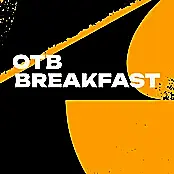Ciaran Frawley was the man of the match for Leinster against Ulster on Saturday. The young Leinster out-half started at inside centre for the first time in his career and added a new dimension to his team's backline.
Leinster tried something new last week. Leo Cullen had six forwards and two backs on his bench against Munster. It's a strategy that worked for South Africa during last year's World Cup. With a plethora of back-row talent at his disposal, Cullen considered it a worthwhile excursion.
Six backs on the bench is not yet a widespread evolution of the sport but it's one of two new approaches that have developed over the last 12 months. The other is having a second out-half in the backline.
Beauden Barrett of New Zealand is responsible for that. Famously a world-class 10, Barrett moved to 15 to accommodate Richie Mo'unga in the team. Both players were effective in their respective roles, not sacrificing quality to fit two playmakers into the same team. An already potent attack now had two playmakers to initiate phases.
Leinster once had Joey Carbery coming through their ranks as a fullback. He would have given Cullen's side a dual playmaker attack similar to that of New Zealand. With Carbery now in Munster and Sexton being rested this weekend, Cullen instead turned to young Ciaran Frawley.
Frawley started at 12 while Ross Byrne started inside of him. It was Frawley's first start in the centre having played 25 times at out-half previously.
Andy Farrell likely isn't looking to change his inside centre anytime soon. Stuart McCloskey, Bundee Aki and Robbie Henshaw are high-end starters. But Frawley is only 22, he's not playing for the now as much as he is for the future. And more significantly, Cullen is showing his willingness to adjust. McCloskey, Aki and Henshaw all have their differentiating qualities but they're of a similar style.
Frawley isn't the hulking body or heavy hitter. He's an axis point, a passer who creates space through invention rather than brute force. He won't start any time soon but his performance on this day offered promise for the future.
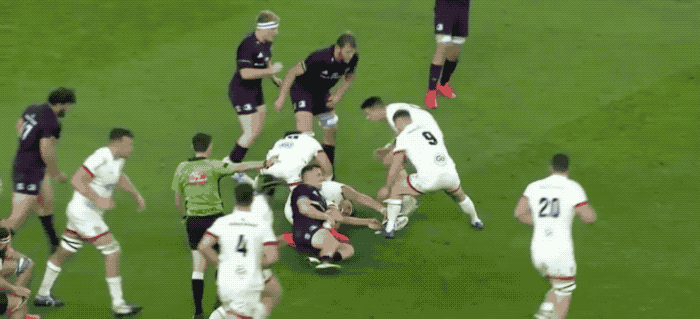
The first concern that needs to be addressed when starting two out-halves is defence. Facing McCloskey should have meant handling a barrage of crash balls all game. Ulster never really got going though, they were almost as lifeless as they were against Connacht the previous week.
So Frawley didn't get to stonewall the bigger man in defence but he did show good awareness and a willingness to play with physicality in the defensive line. This phase comes with 66 minutes on the clock. Frawley, with 12 on his back, establishes across from the second receiver. He drifts onto the bigger man and puts in a good contact when he receives the ball.
Frawley doesn't stop the pass but he disengages as soon as the ball is gone to stay active on the next receiver. His presence prevents Rob Lyttle from offloading the ball comfortably.
In the first half, Frawley came up with an impressive turnover in the middle of the field.
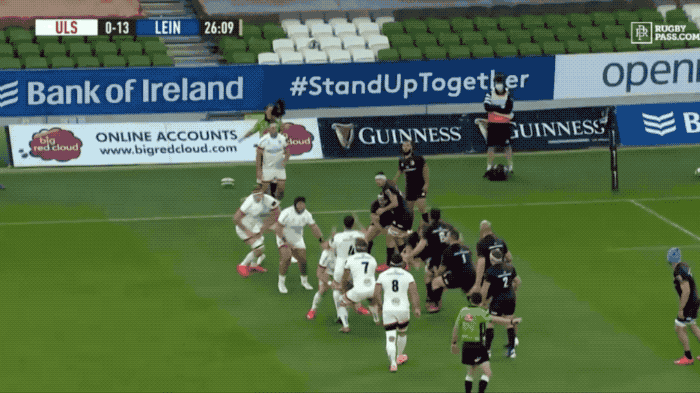
Ulster began this phase with a lineout just outside the Leinster 22. An ideal attacking platform.
Before Frawley's involvement, Will Connors stops Ulster's first phase by meeting McCloskey in the 10 channel. This is quality openside play from the flanker.
He protected his out-half and allowed the Leinster defence to drift while not conceding ground in the tackle.
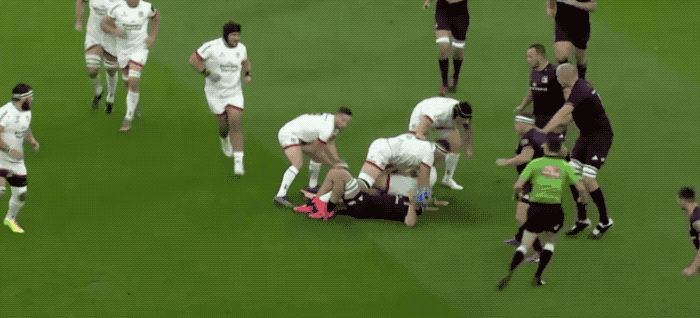
Jacob Stockdale started at fullback for Ulster. Stockdale's value hitting the line from fullback is huge. But Ulster use him as a decoy on this occasion.
He hits Frawley's channel hard, bouncing off the Leinster centre as the ball travels behind him. Frawley trails the play across the field and is in the perfect position to get over the tackle as the ball carrier goes to ground.
Frawley's posture is excellent and he shows strength to hold off the attention of Ian Madigan. He's not going to hold off many backs or forwards, Madigan's not an intimidating physical presence. But he did maximize his opportunity by playing with good technique on this occasion.
Surviving these scenarios will be tougher against a better quality of opponent. For whatever reason, Ulster haven't retained their form through the COVID-19 break.
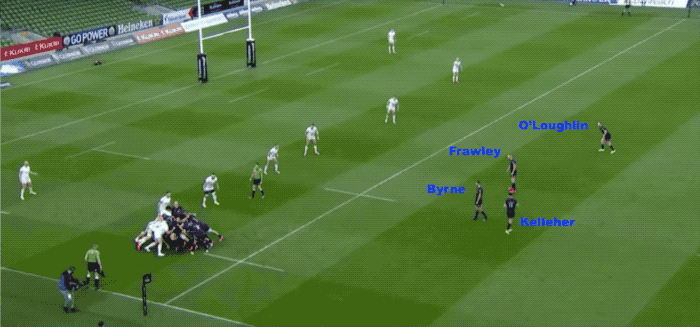
Leinster scored an early try. Frawley was the instigator as the protagonist in a set-piece move. He begins the play at second receiver.
Frawley is actually a step in front of Byrne inside of him, while Rory O'Loughlin is high up too to create a flat line. Cian Kelleher drifts behind them just before the ball comes out of the maul.
Despite being the second receiver, Frawley catches the ball from Jamison Gibson-Park on a skip pass. This changes the angle of attack for Leinster.
The three immediate defenders in front of Frawley are drawn to his flat line. The widest of those three defenders recognizes Byrne looping out the back. O'Loughlin's line is too flat so that defender thinks he can both occupy the passing lane to O'Loughlin while tracking Byrne. But by stepping in he takes himself out O'Loughlin's way.
While he played very well on Saturday, Jacob Stockdale's positioning might have been a problem on this occasion. He overplayed the blindside, wary of the threat of Gibson-Park breaking down the sideline off the maul. That left space for Frawley to poke the ball into. The collision between O'Loughlin and Stockdale broke the ball, which was scooped up by Frawley who had quickly followed up his kick.
Frawley showed some courage to dive onto that breaking ball after showing off his technique kicking the ball through. He was also willing to take the ball right up to the line when he kicked it through.
Robbie Henshaw created a try for Gary Ringrose with a similar style of kick against Munster. That wasn't a set-piece move but Henshaw stepped into first receiver while Johnny Sexton worked behind him off the ball.
A majority of Ireland's attack has gone through Sexton when he's been on the field. Leinster do a better job of pulling the defence in different directions.
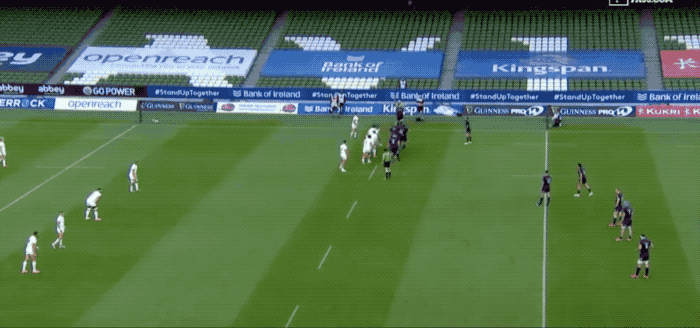
A few minutes after their first score, Leinster showed off the flexibility of their attack with another set-piece move. This time they incorporate both out-halves in a chain. Frawley begins the play behind Byrne and follows the ball as Byrne throws a skip pass to a wider point. Once he receives the pop back into space, he connects with Rob Kearney.
Ulster defended this play well. Stockdale was in a good position to tackle Kearney on a flat ball. The benefit of having Frawley and Byrne on the field together is the range of passing Frawley offered. Frawley negates Stockdale's positioning by pushing the ball onto Kearney's outside shoulder.
It's perfect placement that allows Kearney to generate forward momentum. This gives Leinster clean possession at the next ruck.
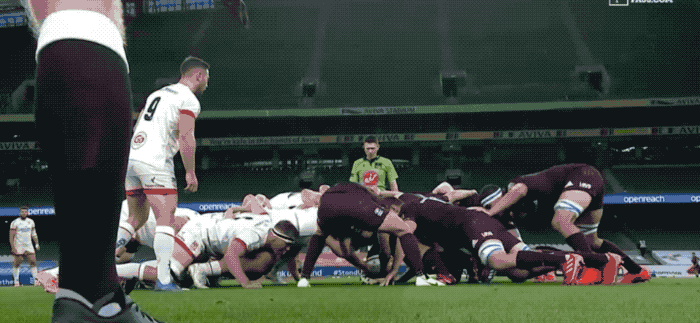
Later in the first half, Leinster used Frawley as an isolated first receiver off the base of a scrum on the left side of the field. By having Max Deegan pick the ball off the back of the scrum and deliver to Frawley hitting the line hard, they could loop Gibson-Park around while Byrne and the rest of the backline reset themselves to a wider position.
Leinster drew Ulster in tight to attack out wide then kick into the space in behind them.

From the base of this scrum in the second half, Leinster put Byrne behind the scrum while Frawley began in a wide position.
Byrne and Kelleher run behind Frawley with Byrne running wide while Kelleher makes a sharper cut inside of him late in the movement. Frawley takes the ball to the line and then gives an accurate pass back to Kelleher to hit the line at speed.
Leinster had run this same action early in the second half but from the opposite side of the field and Frawley found Byrne to shift the ball wide. Byrne had the opportunity to throw a ball wide that would have given Kelleher a one-on-one in space but he took the ball into contact instead.
When Joey Carbery initially came through for Leinster and Ireland it was his willingness to take the ball to the defensive line that stood out most. Frawley repeatedly put himself in those same positions in this game.
Ireland only have four teams to create their national pool from. That creates limited opportunities for experimentation or philosophical exploration. The IRFU have had a clear focus on bruising centres but the national team has also been overwhelmed physically by Manu Tuilagi in their last three matchups with England.
Frawley isn't necessarily the change they need but Leo Cullen's philosophy might be.
Team of Us. Everyone In.
Vodafone. The main sponsor of the Irish Rugby Team
Download the brand new OffTheBall App in the Play Store & App Store right now! We've got you covered!
Subscribe to OffTheBall's YouTube channel for more videos, like us on Facebook or follow us on Twitter for the latest sporting news and content.
